Reverse osmosis and distilled water are both pure and are ideal for folks who want to use or drink water that contains very few-to-no harmful impurities.
The main difference between reverse osmosis water and distilled water is how they’re produced: RO water is made by membrane separation, while distilled water is formed as a result of evaporation and condensation.
Here, we’ve discussed the 7 key differences when comparing reverse osmosis vs distilled water:
| Feature | Reverse Osmosis | Distilled Water |
|---|---|---|
| Purification Process | Filters water through a semi-permeable membrane | Boils water until it evaporates, then condenses it |
| Water Quality | Removes most impurities, but may contain some dissolved gasses and organic compounds | Removes most impurities, but may contain traces of chemicals, metals, and particles with high vapor pressure |
| Uses & Applications | Drinking, cooking, appliances, plants | Medical equipment, irons, humidifiers, lead-acid batteries, laboratory experiments |
| Speed of Water Purification | 50-800 gallons per day (GPD), depending on system size and type | Slow (5-6 hours per gallon) |
| Water Taste | Slightly more complex flavor profile, can be remineralized | Flat or bland |
| Availability | Widely available for home use | Less commonly available for home use |
| Cost of Production | Higher upfront cost, higher maintenance cost | Lower upfront cost, lower maintenance cost |

Table of Contents
⚗️ Difference 1: Purification Process
The RO water filtration process is very different from the water distillation process.
Reverse osmosis water is produced as a result of filtering through several water filter stages, including a semi-permeable membrane, which physically removes contaminants.
Distilled water is produced by boiling water until it evaporates, then condensing it into a separate container, leaving the impurities behind.
RO Purification Process
Here are the main stages of the RO water purification process:
- Pre-filtration: Sediment pre-filter for mechanical filtration
- Carbon pre-filter: Removes chlorine & other chemicals
- RO membrane: Screens out impurities with pores as small as 0.0001 microns
- Post-filter: Typically a carbon polishing filter, removes lingering tastes/odors
- (Optional) Remineralization filter: Adds healthy trace minerals back into water
This process takes place in a reverse osmosis system. Water is forced quickly through the filter stages and impurities are removed in each stage.
At the RO membrane, rejected contaminants rebound back into the RO chamber and are flushed down a drain with a small amount of wastewater.
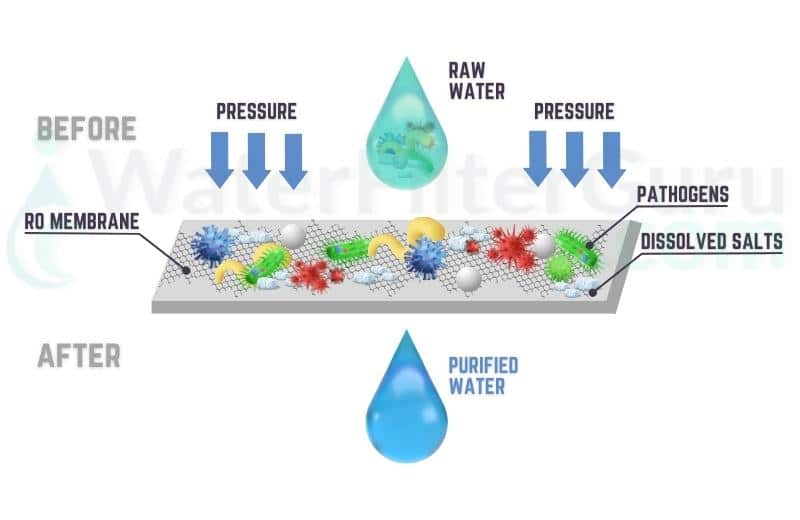
Water Distillation Process
The main stages of water distillation are:
- Boiling: Water is heated in a boiling chamber until it reaches boiling point
- Evaporation: The boiling water evaporates and travels as steam into a cooling corridor
- Condensation: The steam is cooled and condenses back into liquid form
- Collection: The condensed water is collected in a clean container
The majority of impurities have much higher boiling points than water and are left behind in the boiling chamber.
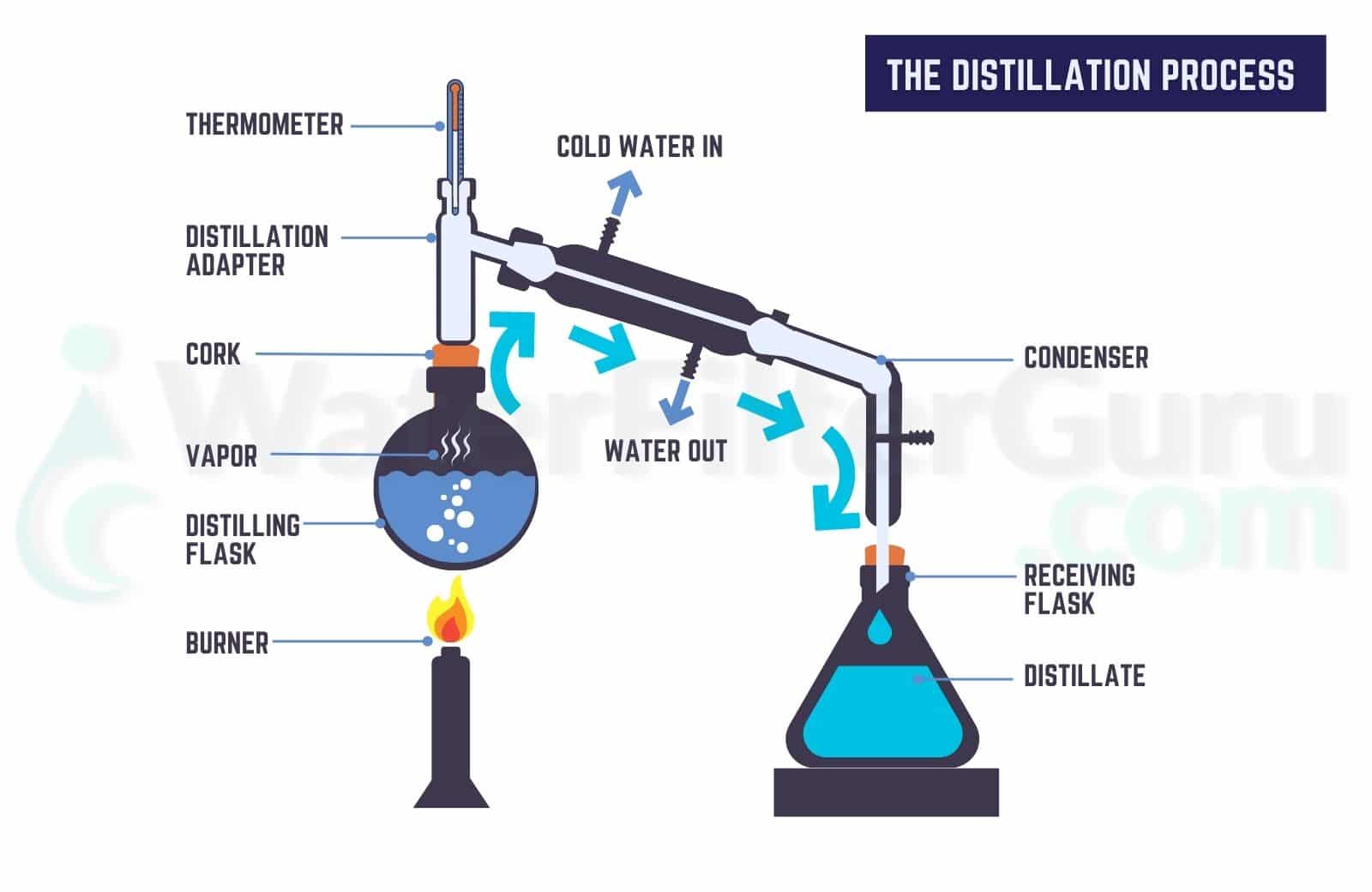
🚰 Difference 2: Water Quality
Reverse osmosis water and distilled water are both very similar when it comes to purity. But each water type may contain certain impurities that aren’t completely removed by the purification process.
| Feature | Reverse Osmosis (RO) Water | Distilled Water |
|---|---|---|
| Purification method | Pressure forces water through a semi-permeable membrane | Heating water to steam, then condensing steam |
| Contaminants removed | Metals, bacteria, most chemicals, salts, minerals (unless remineralized), fluoride, radioactive elements | Bacteria, viruses, dissolved minerals and salts, some chemicals |
| Impurities potentially remaining | Pesticides, herbicides, fungicides, some dissolved gases, organic compounds, some viruses | Traces of chemicals with high vapor pressure (e.g., mercury), particles with high vapor pressure |
| Microbial safety | May not completely eliminate some viruses | Sterilizes water, removes bacteria and viruses |
| Mineral content | Low in minerals, unless remineralized | Very low in minerals |
| Taste | Can be flat or crisp (depending on remineralization) | Often described |
RO Water Quality
Reverse osmosis water is usually free from metals, bacteria, most chemical contaminants, salts, minerals (unless the water is remineralized), fluoride, and radioactive elements.
Reverse osmosis filters may struggle to completely eliminate pesticides, herbicides, and fungicides.
RO water may also still contain dissolved gasses and organic compounds after treatment. Some of these impurities may be able to pass through the RO membrane pores.
Finally, very tiny contaminants, like some viruses, may not be removed during the RO process.
See this 2018 research paper for more information on the contaminants removed by the reverse osmosis process.
Distilled Water Quality
Distilled water is also usually free from metals, lead, nitrate, and dissolved minerals and salts.
Water distillation sterilizes water by boiling it, which kills bacteria, viruses, and other microorganisms. That makes water distillers a more reliable treatment than RO systems for non-potable water.
Distilled water may contain traces of chemicals, metals, and particles with high vapor pressure, such as mercury, which may be capable of evaporating and condensing with water during the distillation process.
Water distillers often come with an optional carbon post-filter to remove any remaining impurities that may have survived the distillation process.
This expert report by the University of Nebraska-Lincoln discusses the contaminants removed and not removed by water distillation.

📥 Difference 3: Uses & Applications
Reverse osmosis water and distilled water can often be used interchangeably in many applications, but there are specific instances where one water type might be more suitable than the other due to differences in their composition.
| Uses & Applications | Reverse Osmosis Water | Distilled Water |
|---|---|---|
| Drinking Water | Yes | Yes |
| Cooking | Yes | Yes |
| Appliances | Yes | No |
| Plants | Yes | Yes |
| Medical Equipment | No | Yes |
| Irons & Humidifiers | Yes | Yes |
| Lead-Acid Batteries | No | Yes |
| Laboratory Experiments | No | Yes |
RO Water Uses
Common uses of RO water are:
- Drinking Water: RO water is suitable for drinking and is often used for this purpose in homes. Its lack of impurities makes it safer and cleaner than normal tap water.
- Cooking: RO water can be used for cooking, and its lack of taste-affecting contaminants (like chlorine) makes it a good option for certain recipes.
- Appliances: RO water can be used in appliances like coffee makers, ice machines, and humidifiers. Demineralized RO water prevents a buildup of minerals that can affect the performance and lifespan of these devices.
- Plants: RO water is suitable for watering plants because it lacks the minerals that may accumulate in the soil over time and affect plant health.
Distilled Water Uses
Some of the most common distilled water uses are:
- Medical Equipment: Distilled water is often used in medical equipment, such as CPAP machines and laboratory instruments, where it’s crucial that water lacks impurities.
- Irons and Humidifiers: Distilled water is also recommended for steam irons and humidifiers to prevent mineral deposits that can impair their functionality.
- Lead-Acid Batteries: Distilled water is commonly used to top off lead-acid batteries in vehicles.
- Laboratory Experiments: Distilled water is frequently used in laboratories for experiments and analyses that require a high level of water purity.
⏱ Difference 4: Speed Of Water Purification
If you plan to purify your drinking water at home, producing RO water is much faster than purifying water with distillation.
RO Water Purification Speed
A reverse osmosis system provides near-instant access to purified water.
Water flows straight through the filters and out of the faucet or water dispenser, powered by water pressure from your plumbing system or an electric pump.
From our own experience reviewing reverse osmosis systems, we’ve found that the average filtration speed of a point-of-use RO filter is 50-800 GPD (gallons per day), depending on the system size, type, and capabilities.

Water Distillation Speed
Distilled water takes much longer to produce – typically 5-6 hours for a single 1-gallon batch of water.
The evaporation and condensation processes are slow, and purified water condenses literally drop-by-drop into the container.
If you want instant access to purified water, water distillers aren’t the solution.
🔎 Difference 5: Water Taste
RO water may retain some minerals and salts, while distilled water is typically free from all dissolved minerals, which means there are some taste differences between the two.
RO Water Taste
While RO systems remove the majority of minerals and salts, around 10-20% of minerals like calcium, magnesium, and sodium typically remain.
This means RO water has a slightly more complex flavor profile than distilled water.
Many modern reverse osmosis purification systems have a built-in remineralization filter, so you can get access to healthy minerals in the water, which improve its taste and health properties.
In this case, reverse osmosis water has a more alkaline, appealing taste than distilled water.
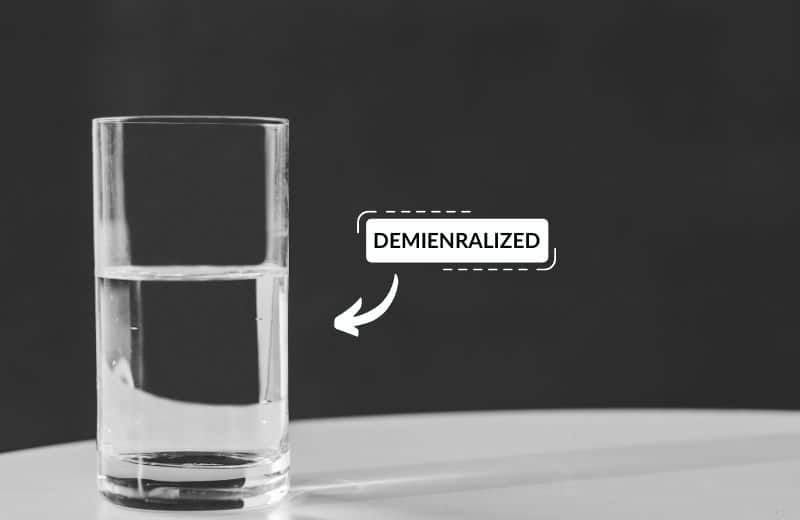
Distilled Water Taste
Distilled water has a taste that’s often described as “flat” or “bland”. It tends to be blander than RO water because 100% of minerals and salts are removed by the distillation process.
Distillation systems also don’t have a remineralization filter stage, so if you want to add minerals to your distilled water, you’ll need to use mineral drops.
🏪 Difference 6: Availability
Both RO water and distilled water are available to buy in most supermarkets and online. But if you plan to purify your water at home, RO systems are more widely available than water distillers.
RO System Availability
Reverse osmosis systems are sold by dozens of manufacturers in the US.
There are tens of systems to choose from – the most popular are under-sink RO systems and countertop RO systems, but whole-house units are also available.
Water Distiller Availability
Water distillers are less commonly available for domestic use in the US, and there are fewer options on the market.
Only a handful of manufacturers sell countertop water distillers. They’re more commonly sold for industrial and commercial use.
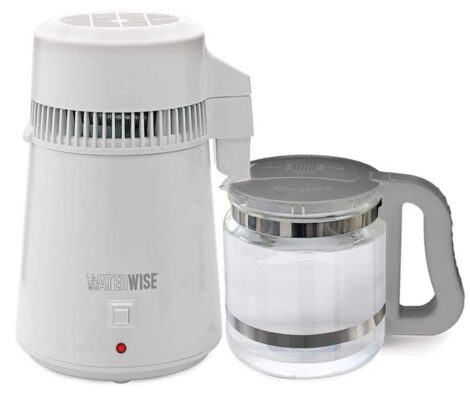
💰 Difference 7: Cost of Production
Water distillers and reverse osmosis systems are both cheaper than buying bottled water in the long run, but producing distilled water is the cheapest.
Reverse Osmosis Water Production Cost
Reverse osmosis units have a higher upfront cost.
An under-sink or countertop reverse osmosis unit costs $550-$1,000 or more, depending on its features.
The cost of maintaining a reverse osmosis system is also higher because the filters and semi-permeable membrane require replacing every 6-24 months.
Plus, you’ll notice a very small increase in your water bill because RO systems produce some water waste.
See our guide to reverse osmosis system cost for more information.
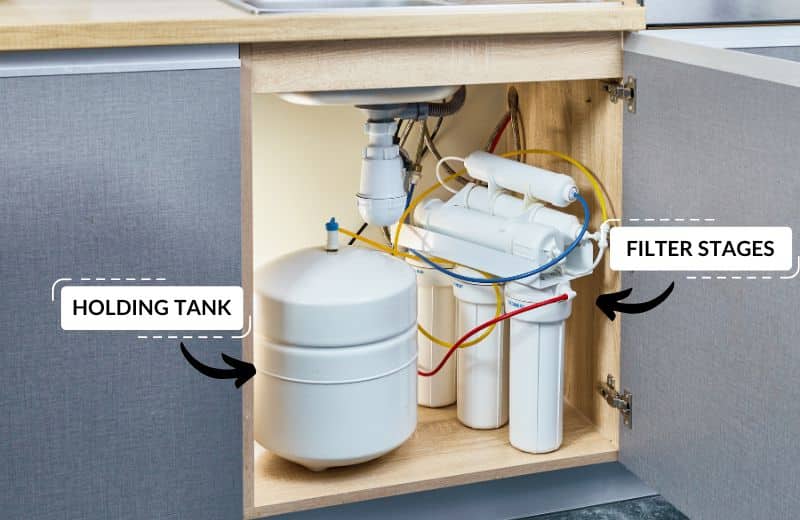
Water Distillation Cost
Water distillers cost around $200-$650 upfront, depending on their size and capacity, and their maintenance costs are lower.
Water distillation systems use electricity, which will add a small cost to your monthly bill. Water distiller brand AquaNui says that household water distillers use about 3 KWH of power to produce one gallon of distilled water. Assuming that you’re on the average US electricity rate of 10 cents per KWH, you’ll pay around 30 cents to produce 1 gallon of distilled water.
There’s also the cost of the carbon post-filter (if you choose to use it).
Related:
- Is Distilled Water Safe to Drink? My Complete Guide
- Tap Water vs. Distilled Water: Which is Safer for Consumption?
- Can I use RO Water in a Humidifier?
- How to Store Distilled Water
🆚 Is Reverse Osmosis Water or Distilled Water Better?
There is no definite “best” choice between reverse osmosis water and distilled water. It just depends on what you prefer.
Reverse osmosis water might be best if:
- You want to purify your water at home with a fast method.
- You prefer water that has been remineralized (trace minerals are often added back into RO water after purification).
Distilled water might be best if:
- You want the purest water type available.
- You’re looking for a more cost-effective at-home water treatment solution
Both water types are equally suitable for the majority of jobs around the home that require pure water, but remineralized RO water is better for drinking because it tastes nicer and contains healthy alkaline minerals.
🧠 FAQ
Is reverse osmosis water the same as distilled water?
No, reverse osmosis water isn’t exactly the same as distilled water. RO water is made by sending water through a semi-permeable membrane in a filtration system, while distilled water is made by boiling water until it evaporates, then condenses into a separate container.
Is reverse osmosis better than distilled?
Reverse osmosis water tends to be better than distilled water for drinking because it has a slightly enhanced flavor and can be more easily remineralized. However, the best water type depends on what you plan to use it for. For instance, certain medical devices may require distilled water only.
